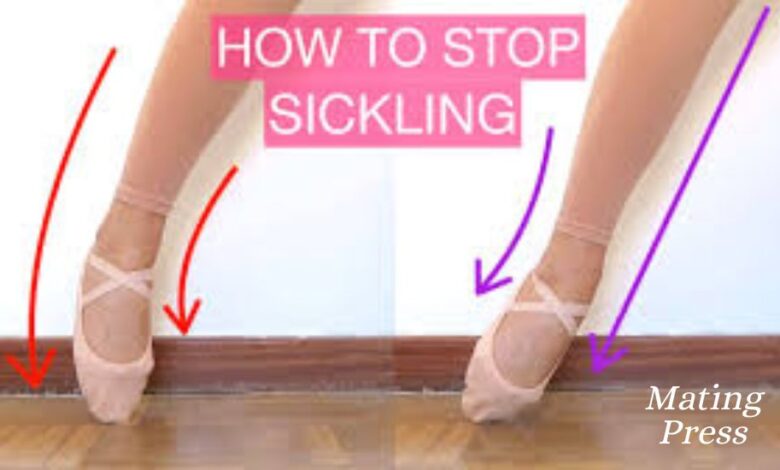Sickled Feet: Transform Your Dance Technique and Prevent Injuries
Sickled Feet: Addressing the Issue in Dance

In the world of dance, particularly ballet, precision and alignment are paramount. One of the critical aspects of a dancer’s technique involves the position and alignment of their feet. A common issue that dancers face is “sickled feet.” This article delves into what sickled feet are, their causes, impacts, and ways to prevent and correct this issue.
What is Sickled Feet?
Sickled feet refer to the inward curving of the foot at the ankle, causing the toes to point towards the midline of the body and the heel to drop back. This misalignment disrupts the straight line that is essential for proper dance technique. In ballet, a sickled foot can break the aesthetic line from the hip to the toe, leading to potential injury and affecting the dancer’s overall performance.
Causes of Sickled Feet
Intrinsic Factors
The natural structure and alignment of a dancer’s foot can predispose them to sickling. Dancers with high arches, flexible ankles, or specific bone and joint configurations may find it more challenging to maintain proper foot alignment. The shape and alignment of the bones and joints influence how the foot rests and moves, making some dancers more prone to sickling.
Extrinsic Factors
Improper technique and insufficient training are significant contributors to sickled feet. Dancers who do not receive adequate guidance may develop habits that lead to improper foot positioning. Lack of strength and flexibility in the foot and ankle also play a role. Weak muscles around the ankle and foot can result in instability and improper alignment, increasing the likelihood of sickling.
Comprehensive Guide to Sickled Feet: Understanding and Addressing the Issue in Dance
Sickle Feet
Sickle feet is a term used to describe a misalignment in the positioning of the foot, where the toes curve inward towards the midline of the body, and the heel drops back. This condition can occur naturally due to the inherent structure of the foot or as a result of improper technique and insufficient muscle strength. Sickle feet are particularly problematic for dancers as they can lead to increased strain on the tendons and muscles of the foot and ankle, causing injuries such as tendonitis, sprains, and even fractures. Addressing sickle feet involves a combination of strengthening exercises, proper training, and awareness of foot positioning to prevent long-term damage and improve overall performance.
Sickled Feet Dance
In the realm of dance, particularly ballet, the term “sickled feet dance” refers to the undesirable position of the foot where the toes curve inward and the heel drops back. This misalignment disrupts the aesthetic line from the hip to the toes, which is crucial for a dancer’s technique and performance. Sickled feet can compromise a dancer’s balance, posture, and overall movement quality, making certain dance movements more challenging. Preventing and correcting sickled feet in dance requires proper technique training, strength and flexibility exercises, and a focus on developing proprioception to ensure the feet maintain the correct alignment during performances.
What Are Sickled Feet
What are sickled feet? Sickled feet describe a condition where the foot’s natural alignment is disrupted, causing the toes to point inward and the heel to drop back. This condition is particularly significant in the dance community, where proper foot alignment is crucial for both aesthetic and functional reasons. Sickled feet can result from both intrinsic factors, such as the natural structure of the foot, and extrinsic factors, such as improper technique or lack of muscle strength. Understanding what sickled feet are and how they develop is essential for dancers to take proactive steps in preventing and correcting this alignment issue, thereby reducing the risk of injuries and improving their overall dance technique.
Sickle Feet in Dancing
Sickle feet in dancing is a common issue that can significantly impact a dancer’s performance and long-term health. This condition occurs when the dancer’s foot curves inward at the ankle, causing misalignment that disrupts the clean lines essential in dance, particularly in ballet. Sickle feet in dancing not only affect the aesthetic appeal of movements but also increase the risk of injuries such as tendonitis, sprains, and fractures. To combat this, dancers must engage in targeted strengthening and flexibility exercises, practice proper technique, and develop a keen awareness of their foot positioning to maintain optimal alignment and prevent the detrimental effects of sickle feet.
Impact of Sickled Feet on Dancers
Increased Risk of Injury
Sickled feet put excessive strain on the ligaments, tendons, and muscles of the foot and ankle. This strain can lead to conditions such as tendonitis, sprains, and even fractures. Dancers with sickled feet are at a higher risk of developing chronic injuries, which can significantly impact their dance careers.
Technique and Aesthetic Implications
A sickled foot disrupts the alignment of the entire body, affecting balance, posture, and movement quality. This misalignment can make executing certain dance movements, such as turns and jumps, more challenging. Additionally, a sickled foot is aesthetically unappealing, detracting from the grace and beauty of the dance.
Long-term Health Issues
Chronic sickling can lead to long-term foot health problems, including plantar fasciitis and Achilles tendonitis. These conditions cause pain, inflammation, and limited mobility, making it difficult for dancers to continue practicing and performing. Long-term health issues from sickling can end a dancer’s career prematurely.
Preventing and Correcting Sickled Feet
Strength and Flexibility Training
Strengthening the foot and ankle muscles is crucial in preventing and correcting sickled feet. Exercises that target these areas help improve muscle balance and joint mobility. Using resistance tools like a Thera-band can aid in performing specific exercises that correct foot positioning.
Proper Technique and Training
Ensuring proper alignment through correct technique is essential. Dancers should seek guidance from experienced instructors who can provide feedback and corrections. Proper training helps develop the correct muscle memory and proprioception, which are vital for maintaining proper foot alignment.
Proprioception Exercises
Proprioception exercises enhance a dancer’s awareness of their body positioning. Practicing movements with closed eyes and focusing on the feel of the position can improve overall form and help recognize early signs of misalignment. These exercises can be incorporated into a dancer’s regular routine to maintain proper foot positioning.
Adequate Rest and Recovery
Rest is vital for muscle recovery and preventing overuse injuries. Dancers should balance their training with adequate rest periods to maintain foot health. Overworking the muscles without allowing time for recovery can lead to chronic injuries and exacerbate the problem of sickled feet.
Conclusion
Sickled feet are a common issue in dance, particularly ballet, that can significantly impact a dancer’s performance and long-term health. Understanding the causes, impacts, and preventive measures is crucial for dancers to maintain proper foot alignment and avoid injuries. By focusing on strength and flexibility training, proper technique, proprioception exercises, and adequate rest, dancers can prevent and correct sickled feet, ensuring a long and healthy dance career.


